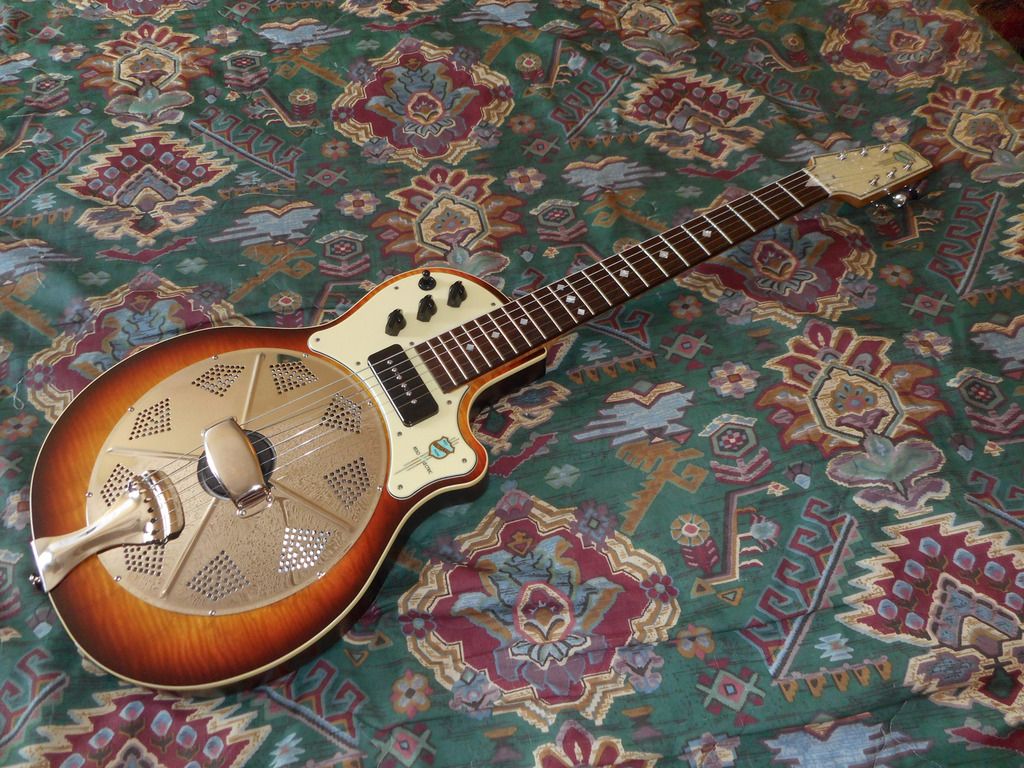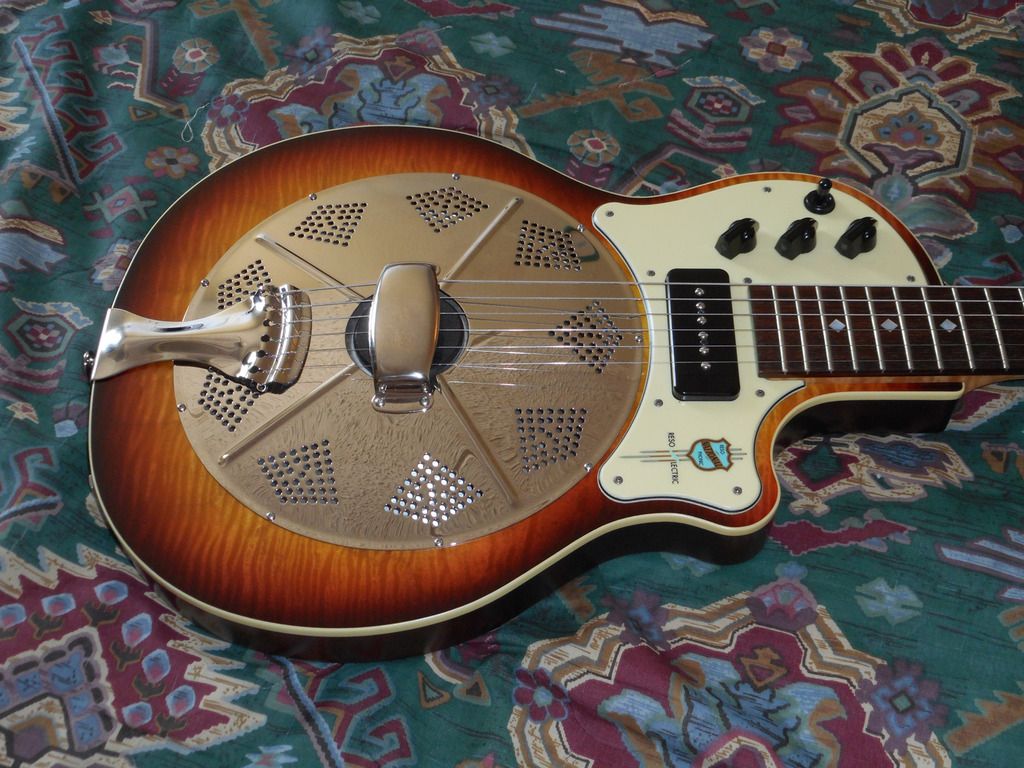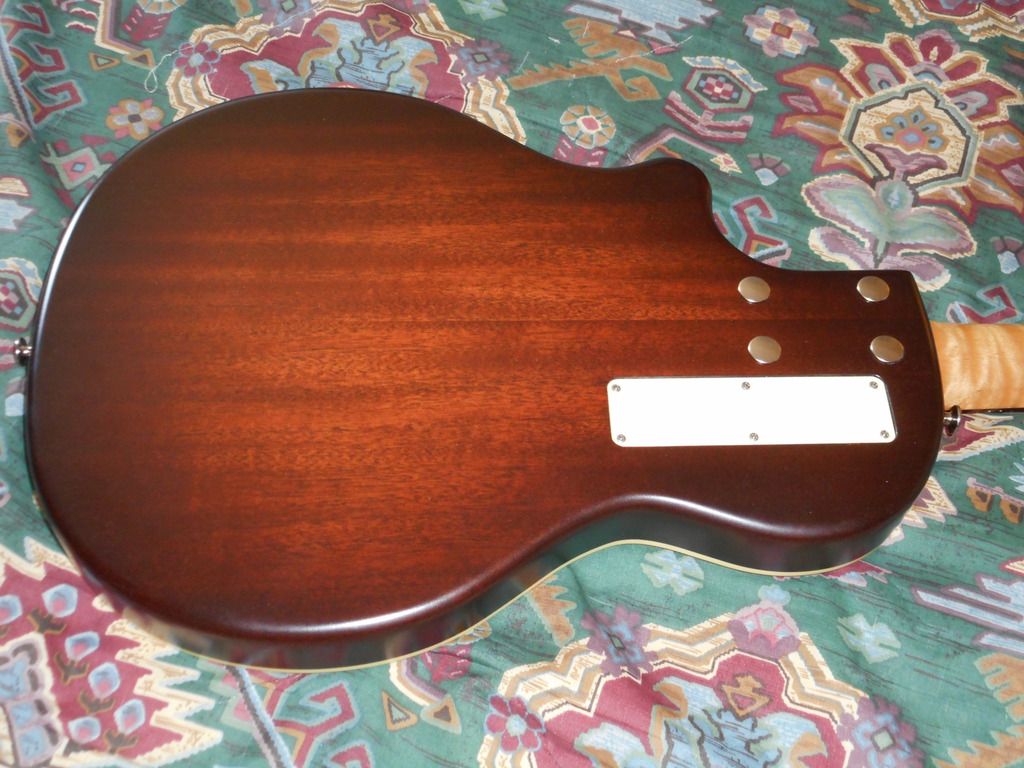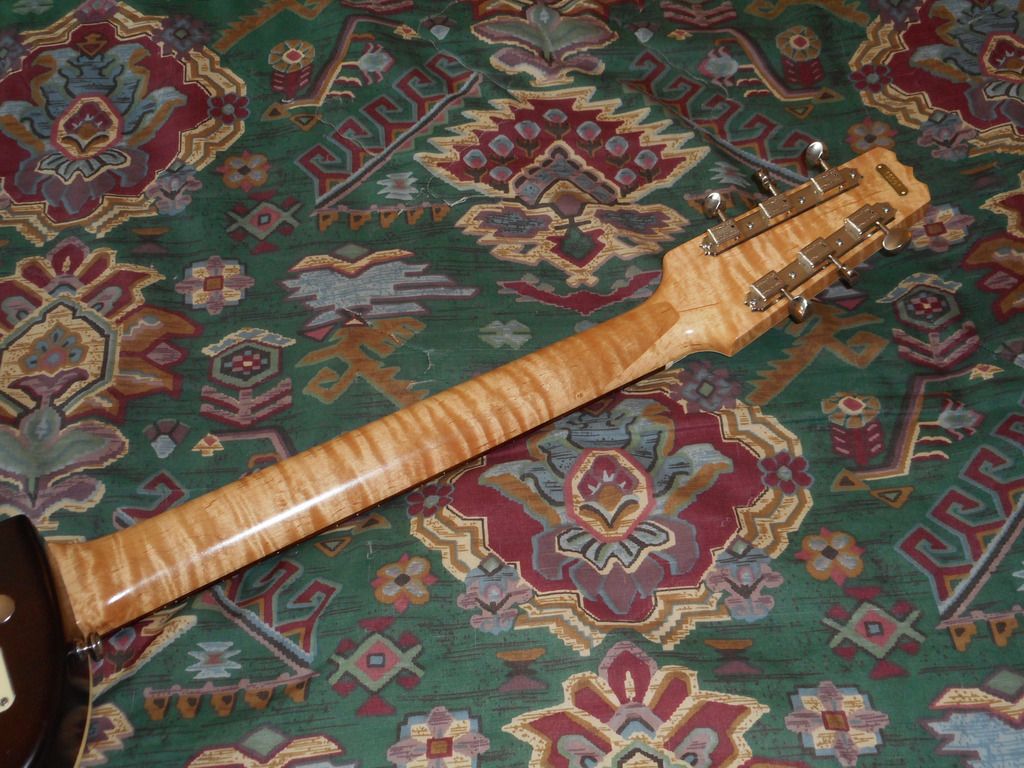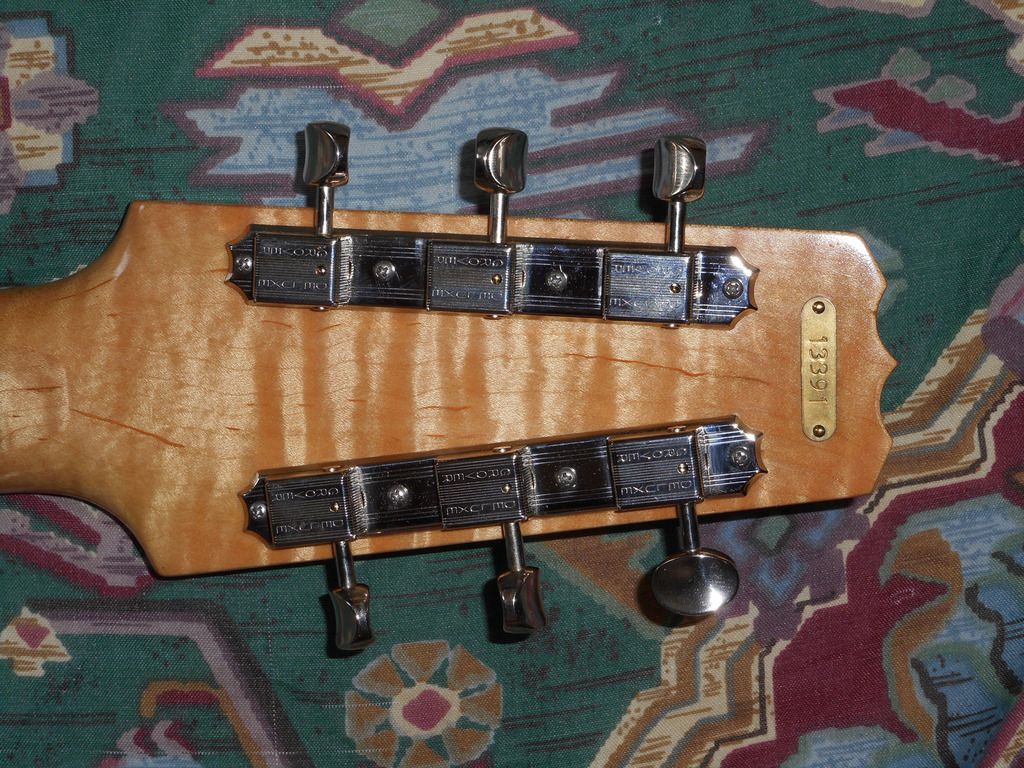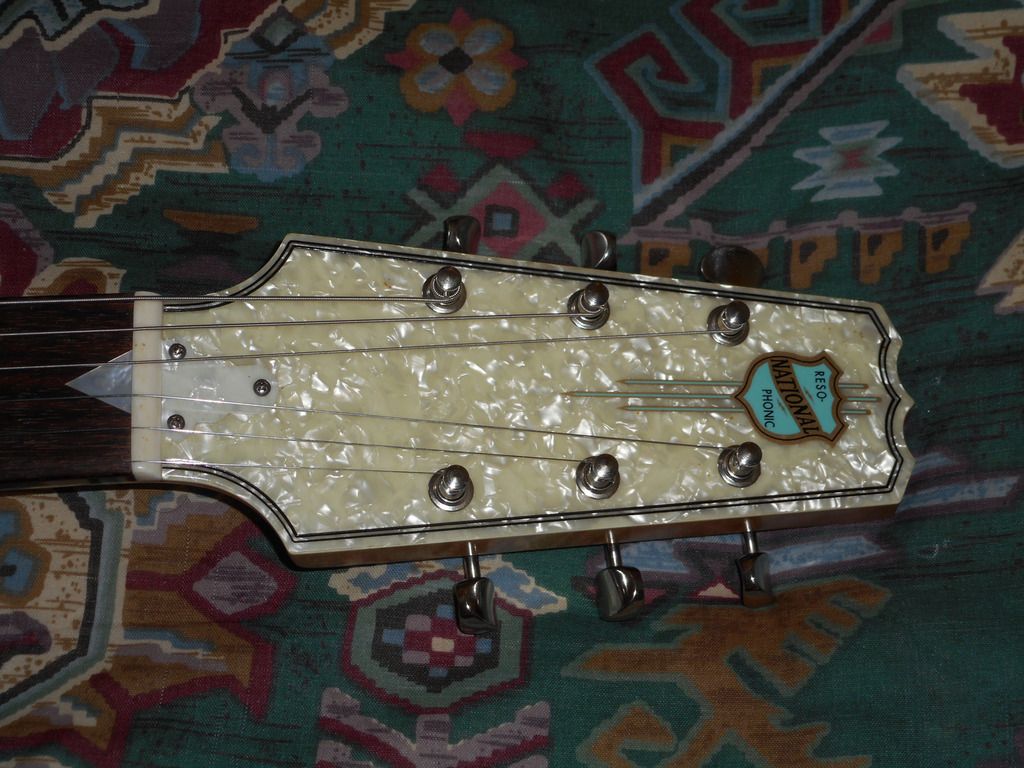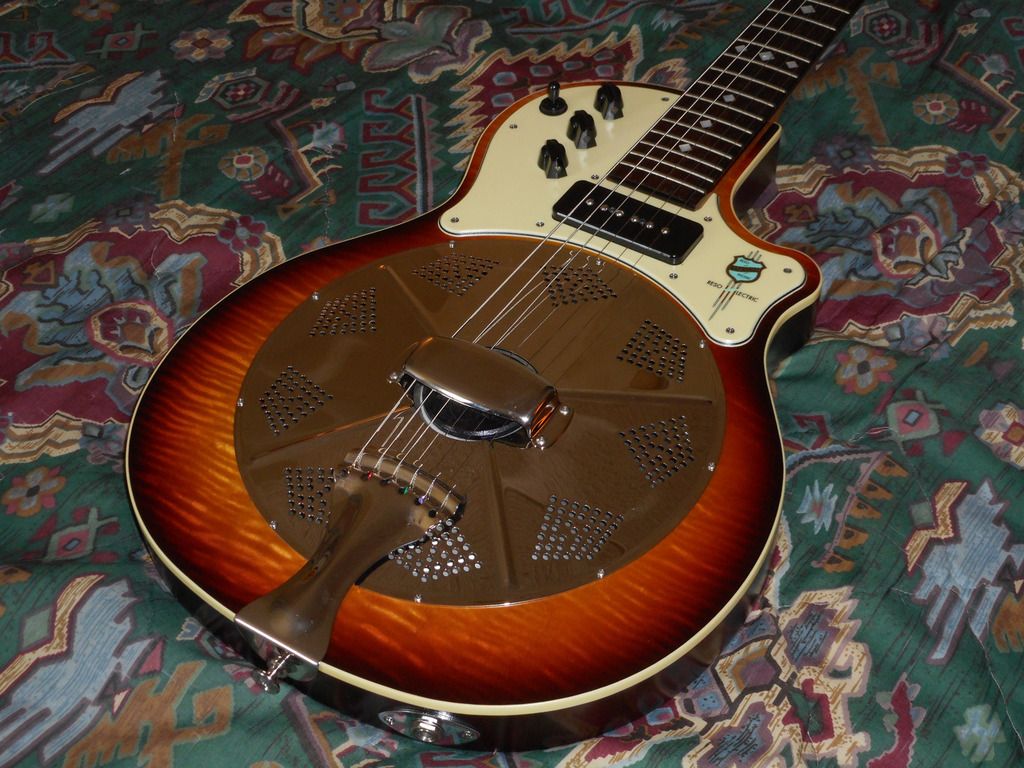The more I play this guitar the more I love it. It is instantly one of my favorites. It has qualities of being a mix between an acoustic guitar and an electric. My style of playing is a mix of several things... I have roots in classic rock, formal training in jazz standards (All of Me, Satin Doll, Green Dolphin Street... Joe Pass kinda playing... but far from Joe Pass, LOL), then roots blues and electric blues. e h
I like a woody, acousticy kinda sound in the guitars I buy. This one has a nice hollow sound when played with the pick or finger style.
Looking at the guitar in a picture, one might think "oh, this guy does old timey music"... thats not really the case. Last night I was playing a RUSH song, "In the End" and it sounded awesome, LOL. Cranking on the overdrive, this beasty is a different animal than a typical solid body guitar with single coils or humbuckers. The best mix I have found so far is having the toggle in the middle position, with both pickups on, and turning down the volume control for the highlander just a bit. It will really dig in for solo work. I wasn't sure if I'd like the 1-3/"4 nut and wide string spacing, but it is great.
National recommends a set of .012"s as a string gauge, I have a set of .011"s on it, tuned down C to C. As you might have read above, that is the tuning I favor. Its not a "slide" tuning, its simply tuning the 6th string to C below E, then tuning the guitar normally after that, each string being of a lower pitch. That lowers the guitar's pitch top to bottom, plus it lessens the tension on the strings so bending is easier (and possible) with the larger string set.
I use this tuning on all guitars, Legacies, Les Pauls, ASATs, and rarely have any troubles. Sometimes on some guitars the action has to be raised just a few thousandths of an inch to keep the tone solid and away from minor fret buzz. This is a tuning I learned from my jazz instructors. When doing finger style jazz standards, it gives you a nice bass line to compliment the rest. I use the tuning for all styles of music. If I want to play a rock song in the key of E, then its at the 4th fret instead of open. Makes for an interesting conversation piece if I happen along an open mic blues jam. Typically guys can never figure out what key I am playing in if they are the "I'll watch your hands for the key" type of guys.
I'm actually lower than a Baritone guitar standard tuning by 1/2 step. Baritone guitars are usually tuned B to B. I'm a little lower, at C, with a regular guitar neck. The Bari-guitars usually have a longer scale length.
I don't play with a band very often, I am usually doing solo stuff, so the confusion of tuning with other guitar players isn't a problem much. I do step on the toes of some bass players, though, LOL. My 6th string is now their 3rd string, 3rd fret C.
I discovered my voice has a lot more power and growl if I am in this tuning. I learned all the blues standards using open tuning like a lot of people did, tuning down C to C, my voice matches with a lot of power. I can change it up with keys, my Bb on my neck at this tuning is now a standard tuned guitar's F#.
I said all that about a different tuning to say that the Resolectric is incredible at this lower tuning. I might get at least some minor fret buzz on the lower strings on Legacies/Strats/Teles/ASATs/Les Pauls, etc... this one is flawless. Some guitars I don't tune down. I have a Les Paul Traditional Pro (burstbucker in bridge, '57 classic in neck, and coil tapping from the gibby factory)... its like my "rocker" guitar and I don't change that one. Instead, I have one of the worn brown Les Paul Studios (in 2008 Gibbo was putting burstbusckers in these, got one of those)... I might string that one up with heavier strings and the lower tuning. The LP Traditional Pro is like one of the best LP's I've ever owned as far as tone, etc for that style guitar. I just don't make any changes. Likewise a brand new (yes its in the registry, Craig, LOL) Legacy HB I special ordered through Dave's Woodstock music. Antique white, mint PG, white pups... #3 - C wide neck (love that neck), annnnd... a reverse headstock and a saddle lock hard tail. I don't change that guitar, either. Its so awesome the way it is, I don't want to change it, haha.
Then I have a PRS-SE Paul Allender model that came equipped with EMG pups and the (way cool) BAT inlays (no birds). It does really well tuned down with the bigger strings. I never play metal... I do like taking guitars that are more recognized in other genres, and doing my "thing" with them. The EMG pickups are really clean and full sounding. They do finger style jazz really well. I actually really love the clean tone I get from those EMGs. More commonly used for over-driving tubes amps for very loud metal music. I like to hear the tones and overtones when I play and the EMGs are very very bodied and full of frequencies.
I think the Resolectric was another of those type of "hey it should be used for this genre" type of buys. More commonly, the resonator guitars are used to play bluegrass, or old time music, or maybe Robert Johnson-era blues. I don't necessarily do any of those types of music.
Another of my favorites is the Gibson Flying V and the Jackson Randy Rhoads model. My favorite V (which I should never have sold) was what Gibby marketed as the "Voodoo V." It was constructed out of a super light ash body, and had G's Dirty Finger pickups. My only complaint at all was that it had almost no inlays (I'm a big round dot or some type of inlay kind of guy). This one had a red skull head at the 5th fret, lol. Of course Albert Kind used a Flying V. So they can be used for the blues. Not much good for sitting and playing, though... haha. I've loved the Randy Rhoads model ever since they came out in the early 80s. I remember playing one at a music store in Minneapolis and it just blew me away. I'm not a whammy bar guy, so when and if I do get another one, it will have the regular tone-Pro's kind bridge. I just never got into whammy bars for anything.
Actually, I can date this a little. In the 1970s, I was in high school and a lot of my guitar heroes played either Les Pauls or Strats. The picked the guitar solos, most commonly from Pentatonic bases some how, and they just played the guitar like it was normally played. Thats what influenced me to want to play guitar. Carlos Santana, Ted Nugent, Alex Liefson (RUSH), Gary Richrath (REO Spedwagon), Peter Frampton... all guys who played the guitar in some kind of normal fashion.
I first heard Eddie Van Halen in like 1978. Frankly I didn't really like what e was doing with the guitar. Granted he is a monster player and just plain smoked his solos, etc. And you gotta just dig what he does for tones... But I didn't care for the finger tapping stuff. To me it just seemed like it wasn't "playing" a guitar anymore like all my guitar heroes did. Not long later, there was a whole industry of folks who took the finger tapping style and whammy bar tricks to an entirely different level, and now we sometimes associate those sounds as "heavy metal."
Along about that time I was graduating high school, and had been in a gigging band since I was 16 years old. I noticed that a lot of rock and roll was I-IV-V or some derivative thereof, and music became kind of boring to me in a way as an ear-playing kinda guy. It just seemed like everything was I-IV-V and pentatonic scales. The very cool guitar solo in Stairway to Heaven was the first note-for-note solo I learned on the guitar, and it is basically all in the A pentatonic. (Howbeit with awesome Jimmy Page flair...).
In 1986 I met a (recording-wise) famous jazz player who had just started giving private lessons. The world was going crazy for finger tapping, and I was bored with I-IV-V stuff, so I kinda virtually "leap frogged" over the entire Big Hair heavy metal styles of the day. I stopped playing rock all together, and my woodshedding time became everything jazz. Either bebop or swing, never some of the John Scofield way-outside kind of jazz. I never cared for Pat Methany either, to me and from what I was being taught, that wasn't true (purest) "jazz" music. The genre is actually "jazz fusion" and not my cup of tea. The kind of jazz I was being fed was the show tunes made into jazz standards type of jazz. The new chords were difficult and presented a huge challenge. I think that is why I fell in love with jazz for so long. Joe Pass became my idol. Herb Ellis, Wes Montgomery, Joe Diorio (met him in L.A., what a fantastic guy), Barney Kessel... these were all new names to me and I ate up any kind of recording I could get my hands on containing that type of sound.
I received private lessons from some really awesome players. I moved to L.A. about that time, and the friend I had traveled out there with was going there to attend Guitar Institute of Technology. She got the the phone number of Phil Upchurch from the Bulletin board at GIT and I was able to meet and study with him for some time. Phil (if you don't know) is the arranger and rhythm guitarist for many of George Benson's gold records. If you've ever heard Benson's "On Broadway" or "This Masquerade" those are arrangements by Phil Upchurch, and he is on their playing rhythm behind George. I think George Benson was my guitar hero bridge between the popular rock culture and a road toward jazz. He's not pure jazz like Joe Pass, he's some where in the middle with a pop edge. Before I even met Phil Upchurch, I could already play notes and sing them at the same time like Benson does. Phil didn't teach me Benson music, though. One of Phil's ultimate heroes is/was Andre Segovia. He had a picture of him and Segovia in his living room that he was incredible proud of. He also had his living room walls intimidatingly posted with dozens of gold records. Phil has played on records with dozens of artists. I was a poor, broke idiot back then, and I had to stop taking lessons from him because I didn't have the money. But his lessons were only $25/hr. About 3 x's the amount I was being paid an hour back then, LOL.
My jazz instructor back east told me when I got to California, that I had to look up Ted Greene for lessons. Ted was one of the most brilliant, talented jazz instructors to ever live. My friend at GIT came through again and I got Ted's number and for the next 2 years studied privately with him at his home in Encino, CA. It was a long assed drive from Huntington Beach where I was living in Huntington Beach to Ted's house in Encino. I think it was about 60 miles across L.A. insane trafffic each lesson. Ted used to comment on how he respected how far I had to drive to get to his house, LOL.
I always scheduled my lesson as the last lesson for the day for Ted. I had to work at a die shop during the day, so evening lessons worked best for me. Did you ever see the Batman movie with Jim Carrey, he played Edward Enigma, aka "The Riddler." He had designed a device that would allow him to suck up all the brain power from whoever he aimed it at... That was what it was like taking lessons from Ted Greene, LOL. I have dozens of sheets from Ted's lessons. He was so over my head with everything, but patient and such a kind soul. He became not only a guitar instructor, but a friend and one helluva mentor. We were close enough that when my guitar had to go into the shop for some fret work, he loaned me his pre-CBS Jazzmaster to keep playing. I also had a gig to play. I don't remember the year, but the jazz combo I was playing with got a gig to play after the major league baseball All Star game... might have been 1987-1988. The only person I remember (I know nothing about baseball) was Orel Hershiser. He played in the game, and was supposed to be at the party some where, but I never met him. I played that gig with Ted's Jazzmaster.

If you don't know... Ted passed away on July 23rd, 2005 at his home in Encino. Studying jazz guitar with Ted is about the equivalent of studying martial arts with Bruce Lee, haha. If you're curious, there is a Ted Greene fan page admin-ed by some of his students at
http://www.tedgreene.com/
There is a lot of information about him on there, including PDF sheets of lessons material for free download.
I carried a cassette recorder to all my lessons with Ted and recorded them all. When I knew I was going to be leaving California and terminating my lessons, I scheduled one 2-hour lessons with him and asked him to go page-by-page and review every sheet he had given me. I recorded all of that, too.
During this period while most of the guitar world was buying Ibanez shredder guitars with Floyd Rose systems, I was studying with Phil and Ted. Whammy bars and finger tapping didn't impress me. At 20-something in age, these jazz instructor impressed me big time.
After two years studying with Ted, my brain was full of guitar stuff. So packed full that it made my head hurt, LOL. Now it was time to digest and find a direction.
Next I started listening to roots blues music. Robert Johnson, Son House, then the post-war guys... Muddy Waters, Jimmy Rogers, anybody that came out of Chicago. Then while living in North Carolina I learned about an eastcoast regional blues style called "Piedmont Blues." Most commonly a finger-style blues played in and around the tobacco warehouses, as compared to a more gutteral style regional blues that developed around the cotton fields of Mississippi (aka, Delta Blues). Blind Boy Fuller was one of the most famous Piedmont Blues guys back in the 1930s. Piedmont Blues has more of a Ragtime sound. It is a bit more complex in its finger style than the typical Delta Blues. I lived in Greensboro, NC fror a time and blues was big there. I frequented an open blues jam at one of the taverns. The Piedmont Blues Society had a yearly battle of the bands festival, and my blues band won the competition one year, LOL.
Now I was hip deep in the blues.
I took all of the knowledge and jazz training, all of the spunk from my guitar heroes of the 70s, and realized the most awesome music in the world for me was blues. I couldn't get enough of blues recordings. I took a job in Mississippi just so I could be closer to some blues history. I lived in Tupelo for a while (Elvs Presley's birthplace) and on the weekends you'd find me either in Memphis on Beale Street, or somewhere down in the Delta looking up historical blues places. I played as a solo street musician in front of "Tater Red's Lucky Mojos and Voodoo Healings" store, LOL... After discovering Clarksdale, Mississippi, I had a regular Saturday night gig playing solo blues at a restaurant in Clarksdale. That's the heart of Delta Blues. Clarksdale. I wrote over 40 blues songs living in Mississippi. I also lived in the Delta for a while in a small itty bitty town named Crenshaw, MS. If you sneezed while you drove through you'd miss it.
While I was there I visited the Stovall Plantation where Muddy had worked before making it big. I visited (one of) Robert Johnson's grave sites in front of the Mt. Zion church... at midnight... and wrote a blues song standing on his grave, LOL. In Tutwiler, MS I researched and found Sonny Boy Williamson II's grave and paid him homage for a day. Also, it was in the Tutwiler train station where W.C. Handy first heard a man scratching a pen knife on his strings in the form of what the man explained was "the blues." So impressed, Handy made his home in Clarksdale. In 1922, he penned a song "The Memphis Blues" which becamse the first song ever published with the word "Blues" in the title, and that's why he is called "The Father of the Blues" today.
Clarksdale is also the place where the famous "Crossroads" exist. The place where Robert Johnson, as legend has it, sold his soul to Satan in exchange for abilities on the guitar. The legend has the intersection of hwy 49 and hwy 61 as its ground zero. There are actually 2 possible intersections, one is downtown Clarksdale, where hwy 61 goes south and hwy 49 continues to the east. You get there just by driving through Clarksdale. The other location, and the one I visited, was next to the Barbee Cemetary, a bit north of Clarksdale, where hey 49 cuts to the west toward Helena, Arkansas. Being a religious man, I stood at the Crossroads and prayed to Go, and I told God I was taking the Crossroads back from Satan, haha. Then I dug my heel into the gravel stones and buried one of my guitar picks there. Right next to me heel mark was a silver dollar-sized quartz rock. Later I had a jeweler make me a mounting for it so I could wear it around my neck as a necklace. I always wear it whenever I play a blues gig. Its a great blues conversation piece.
Tater Red is also an ordained Voodoo high priest. He has made several mojo bags for me over the years. A real mojo bag is a bag of mixed herbs and dusts and certain roots that remain on the Voodoo Priest's altar for a giving amount of time. There is a chestnut looking root called "John the Conqueror" that I would have Tater put in each one. John the Conqueror by Voodoo legend, gives musical luck to the bearer. Tater also sold oils at his store that had magical powers towards musicianship. He also had books on how to practice Voodoo but I never got much out of them.
When I was back in North Carolina, it was just an intense fascination with the blues. By the time I was in Mississippi, I had to try everything associated with blues. Every city in Mississippi I'd visit, I'd go to their library and check out what blues they had on CD. My journey for blues recordings brought me to Ole Miss in Oxford, Mississippi. The music archives at the University of Mississippi ("Ole Miss") has the largest blues collection in the world. Not just CDs. Every form of recording that has ever been made. LPs, cassetes, yes. But also 78 speed records, and (I don't know what you call them) those tubes that have music sketched on the outside of them. As a visitor there, you can listen to everything in their archive. But you can't check it out and take it home unless you're like working on your doctorate for ethnomusicology or something, haha.
I went from being a curious tourist of blues places, to immersing myself as completely and entirely into the scene as possible. Visited the Crossroads several times, visited graves of famous blues folks, dabbled in Voodoo, made jewelry from a rock from the Crossroads, played on Beale Street, regular gig in Clarksdale. Yup, I was in hook, line, and sinker... to the gills.
I figured out after much contemplation and personal inquiry, that blues was what fit me the best. I came from an abusive, blue collar home, not akin to slavery, but I've felt my share of pains. I can put all those life experiences into this music more than I ever could rock or jazz. There is something about the gut-wrenching bends and emotions I can put into the music that just gets me off.
And it way beyond I-IV-V.
Blues takes up every fret of the guitar. From the open notes to the 22nd+ fret. What makes each song I play different is to change up the rhythms, or to add unexpected 7th or 9th chords in the middle some where. And its is NOT a depressing-only kind of music. Slow blues songs might have a faux-ish down side, but here is what I learned about the blues. Let's say you were working your ass off all day as a share cropped in the Delta. When it was the end of the day, and you had musical skills, most likely you played blues back in the day. You didn't come off the field to play some kind of depressing <censored word>. The blues was a celebration and a party. It was a fast song to make the women want to dance. It was the fun you had after a miserable day working in the fields. It was anything but depressing. It was the time of day you popped a cork, sucked down some whiskey and had a BUNCH of fun. If it had always been some kind of depressing music, it would have died years ago.
I never felt depressed when visiting a juke joint in Mississippi. Those people in there are partying and having one helluva time.
I'd also like to say the blues is not "the devil's music" as some like to say. Here's my take on that from BB King. "The devil never created anything." Meaning, only God creates, and only creation can come from God. The devil is a destroyer, not a creator. He is also a usurper, which is how he got cast out of heaven. He wanted to usurp the throne of God and in effect, BE God. At which time he got his devil ass kicked and God pitched him out of heaven. Kind of reminds me of my control freak sister, LOL. As BB explained it, people can take the music and do with it what they want, and they can let Satan influence their lives... but Satan did not create the blues, and it is not "the devil's music."
In fact, listen to anything ever recorded by Mahalia Jackson. 100% centered around her faith and religion, she never sang what folks call "secular" music, and she sang in the style known as "the blues." Another example is Sister Rosetta Tharp... and she wields a wicked Gibson SG... haha... same thing, only Gospel music. And its "the blues" by musical style.
I once went to the "Delta Blues and Gospel Festival" in Greenwood, MS. They had 3 stages. A stage where the national acts played, a "juke joint"stage where local musicians were playing, and a "Gospel tent." I happened along the Gospel tent about the time the Misissippi Mass Choir took the stage. Holy crap. The intensity of what they played for music made the hair stand up on my arms. They had bass, drums, electric guitar and keyboards and they virtually rocked the house. If they played that kind of stuff at a church around here, I might actually go to church, LOL.
Later at the national act stage I got to see Little Milton throw a freaking fit because the sound system was going down, lol. He was yelling at his guitar tech and pitching a 2 year old temper tantrum. Folks left in droves during his show. But the next act was Bobby Rush, and I had fanaggled my way to the edge of the stage. When the sound system went down during his show, he just kept rockin' as if nothing had happened. What an entertainer. In some small way I was reminded not to make a face when I miss a note, but to press on as if the bad note had ever happened. I think of Bobby Rush everytime.
Well, this went from a review of my Resolectirc to a journey down a small portion of Candleman's life...haha....
